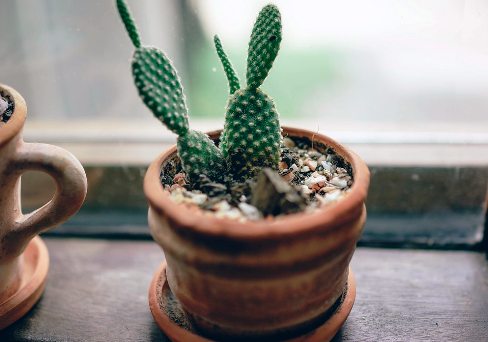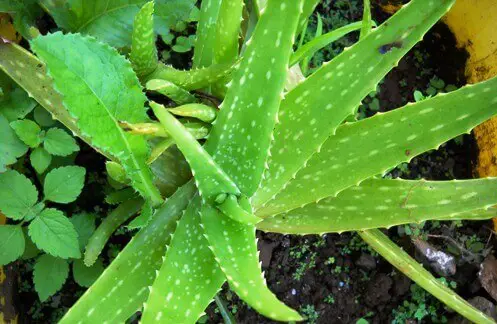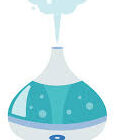Indoor Plants That Absorb Moisture: Natural is Great!
The best indoor plants that absorb moisture can lower humidity considerably without racking up your electricity bills.
They also add quite a kick to your interior decor.
In another article, we looked at helpful tips for how to humidify a room naturally. In this one, we shall look at what plants absorb humidity.
Do plants absorb moisture from the air?

Yes, they do. However, some plants, such as those with broad surfaces and hairy leaves, absorb more moisture from the air.
Desert plants such as those from the cacti family are going to absorb water from the air and keep it in their stems.
Because of the hard, dry desert conditions, these plants have adapted. They have very thin leaves, actually spikes, which limit the amount of water they lose to their surroundings.
Desert plants are adapted to absorbing water through the stoma (minute openings in the leaves and stem).
When you have these plants in your indoor spaces, they will help to lower the humidity as they will be removing water from the air.
Most other plants however absorb most of their water from the soil, through the roots! That’s why they don’t lower the humidity level as much as the broad and hairy-leaved plants.
But is it all glory and no gloom with indoor plants for absorbing humidity? Well, plants need care and attention. They are just like pets!
Another thing that might be going in your mind is: do you still need a dehumidifier if you have indoor plants?
Yes. If you live in Florida where there is high humidity almost through the year, indoor plants that lower humidity will not be enough.
You will still need a dehumidifier to lower the humidity level so that you can sleep comfortably.
Do cactus absorb moisture from the air?

Cactus plants are the king of moisture absorbing plants. They are so good such that you can even use them in high humidity areas such as the bathroom and kitchen.
These plants also absorb water from the air fast. In fact, they are faster than the evaporation process.
These plants are adapted in the following ways to absorb moisture fast:
They have a waxy skin
The small waxy membrane that covers the stem of the cactus plants prevents water loss. It is more like a plastic cover, so it does not allow the stem to evaporate its water. It also helps the plant keep its water.
They absorb water through their spines
They are designed for absorbing water and preventing its loss to the surroundings. More water in and less out!
They have deep-layer stomata
This means that the stomata are deeper inside the body of the leaves, and that prevents the loss of water. Also, the stomata open during the night when the temperature is cooler, so there is no loss of water.
Succulent stems that expand and contract
This is the secret behind succulent plants. They have succulent stems, which have cells that can collapse or expand. When the plant is exposed to water, the cells expand to hold more water. When there is less water, the cells collapse.
Their roots grow shallow and wide
When you water the cactus plant, it absorbs most of the water in the soil through the roots and stores it in the stem. It has roots that spread wide and closer to the surface to absorb the water quickly.
Please note that even if you keep the indoor cactus plants in the bathroom, you still need to water them. However, these are low-maintenance plants, but they still need water.
Other indoor plants that absorb moisture
In another article, we looked at the best position to place humidifiers for indoor plants. In this section, we look at indoor plants that absorb moisture.
They are as follows:
Philodendron – best plant for absorbing moisture in the bathroom
 This is rated as one of the bathroom plants that absorb moisture. If it is good for absorbing the excess moisture in the bathroom, it must be good for the rest of the home.
This is rated as one of the bathroom plants that absorb moisture. If it is good for absorbing the excess moisture in the bathroom, it must be good for the rest of the home.
Since there are many varieties of philodendrons, you can choose the one that grows upwards instead of one that grows like a vine.
Since these plants do not need direct light, you can place them on or close to a curtained window in the bathroom or kitchen.
If you have a few people using the bathroom to shower and bathe all the time, you will not need to water this plant. Bathroom humidity alone is enough.
Aloe Vera: Best indoor plant for absorbing humidity

This succulent plant does well in dry conditions. By dry, we mean that it does not need a lot of rainfall to perform well. It is one of the indoor plants that absorbs moisture from the air.
Besides, many aloe vera species have medicinal value. By planting it, you could hit two birds with one stone.
It doesn’t matter where you place your aloe vera plant. It will do well in well-lit, moderately lit, and poorly lit conditions.
Boston Fern
Not only will the lush green color of the Boston Fern enhance your interior decor a great deal, but it also helps absorb moisture from the air.
And most of the fern family plants do! They will not absorb so much humidity from your rooms as to leave the air dry.
Rather, these houseplants that absorb moisture from the air leave your indoor space feeling cooler and more comfortable.
Orchids
The incredibly colored flowers always have a stunning effect on your interior. However, another benefit is that orchids are moisture-absorbing plants.
They will draw nutrients and moisture from their surroundings, thus making the air in your room dryer and more comfortable.
Cacti: houseplants for humidity
Have you ever seen a combination of beauty and savagery? That is what you will get from your indoor cactus plants.
The large, succulent stems with tiny, needle-sharp thorns are indeed enthralling. They bring a nice desert touch to your home.
However, the overall benefit is that cacti are indoor plants that absorb moisture. Since they are desert plants, they absorb moisture from all around them.
With several of these plants scattered all around your indoor space, there will be less need to crank up that dehumidifier.
English Ivy
 When searching for information on indoor plants that absorb moisture from the air, you will come across the English Ivy.
When searching for information on indoor plants that absorb moisture from the air, you will come across the English Ivy.
But alas! This plant is not only good for lowering humidity, but it is also a cleanser of some sort, as we shall explain below.
When building materials, including paint, age, they start to exude chemicals such as formaldehyde (one of the most common VOC).
They release this in very low quantities. Other things that emit such chemicals include furniture, carpets, cleaning agents, and soaps.
But when you have the English Ivy indoor plant for dehumidifying, it neutralizes the effects of such chemicals.
Since this plant does not require a lot of light, you can place it in low light areas. Such are notorious for growing mold. You can use English Ivy to lower humidity in your low-lit areas.
Peace Lily – Best dehumidifying plants

Peace lily is one of the most effective indoor plants that absorbs humidity from the air. However, it is also poisonous if eaten. Thus, keep it out of the reach of children and pets.
It is very efficient at drawing moisture from the air through its leaves. Your Peace Lily can survive without extra watering if you live in a high-humidity area.
This indoor plant also has other benefits. For instance, it cleans out other contaminants, such as formaldehyde.
Because of its ability to absorb moisture, it can help you keep your indoor spaces free of mold.
Do snake plants absorb humidity?

Not only do snake plants absorb humidity, but they also help to purify the air, albeit minimally.
What we mean by this is that while they might attempt to remove impurities such as VOC (volatile organic compounds), they do it very minimally. Therefore, you will still need to run your air purifier.
Snake plants are superstars for absorbing indoor moisture. In addition, you can keep this plant in spaces with minimal lighting, and it will still thrive.
The leaves are spiky, and the leaves are waxy. The roots spread widely near the surface to absorb a lot of water from the soil.
Also, this plant is adapted to absorbing water and retaining it. It does not lose water to the surroundings. Thus, even when neglected, it still does very well and is evergreen.
Final Thoughts
Indoor plants that absorb moisture, such as the ones that we have discussed here, can help lower humidity at home.
However, this does not mean that you will never need to crank up your dehumidifier, because you might need to.
The good thing is that you can use the dehumidifier water to water your plants.
Even though they will not do all the dehumidifying work in your indoor space, these plants also enhance your interior decor a great deal.

